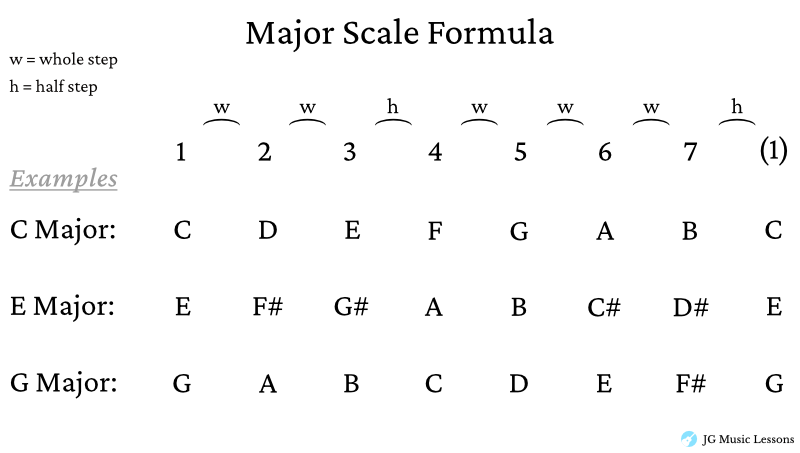One way to enhance your melodies and improvisations on guitar is by harmonizing them—adding notes above or below the melody to create depth and expression.
In this lesson, you’ll learn how to harmonize melodies using two powerful intervals: 3rds and 6ths. These intervals add richness and movement, making your lines sound fuller and more expressive.
Before diving in, I recommend getting familiar yourself with the 5 Major scale shapes, as they provide the foundation for finding harmony notes across the fretboard. Now, let’s explore how to apply 3rds and 6ths to your melodies!
*Included in Pro Membership
Identify which scale to use
Melodies are built from scales, so the first step in harmonizing is knowing which scale the melody comes from. The Major scale is a great starting point, as many melodies are derived from it.
To understand the Major scale, it’s important to learn its formula—the pattern of whole and half steps that create its structure. Here’s how the Major scale is built:

For example, here is one way to play the C Major scale in one position:


Once you know the formula that makes up a Major scale, you can also apply this to start on any given note to find the notes of other Major scales.
How to harmonize a melody
Once you’ve identified the scale, you can start harmonizing by adding notes from that scale. One of the most common ways to do this is by using 3rds—playing a note and then adding the third note above it in the scale.
For example, in C Major, harmonizing in 3rds would look like this:
• C → E
• D → F
• E → G
• F → A, and so on.
To find a 3rd above any note, simply skip the next note in the scale and play the one after it.
Below, you’ll see the Major scale with 3rds added to each note, along with a guitar-friendly way to play them. Pay attention to the finger numbers above the notes to help with comfortable fretting-hand positioning.
C Major scale harmonized in 3rds

C Major scale harmonized in 6ths
For 6ths, count six notes up from the melody note within the scale. Another way to think about it is that 6ths are inverted 3rds—essentially, a 3rd interval shifted an octave lower.
For example, in C Major:
• C → A
• D → B
• E → C
• F → D, and so on.
6ths create a more open and melodic harmony, making them a great choice for adding warmth and movement to your melodies. Try the example of 6ths on guitar below.

Melody example in C
Before we dive into harmonizing, let’s start with a short melody in the key of C Major that we’ll use for the following examples.

Here is a backing track of what this melody sounds like:
Now try this example of the same melody now with the interval of a third above the notes.
3rds above the melody

3rds below the melody
You can also try thirds below the notes by skipping the previous note of the scale.
Here is what this would like:

How to harmonize a melody in 6ths
Now, let’s harmonize the melody in 6ths which create a fuller sound to the melody line.
6ths above the melody

6ths below the melody

Harmonization tips to create variations in music
Harmonizing notes is also a great tool to create variations in music. You might want to play a single line the first time around and then harmonize the melody to create a variation.
Let’s see some examples below.
Variation 1
In this example, we’ll start measures 1 and 2 with the original melody. Then we’ll use 6ths above the melody on measure 3 and the 3rds above the melody at the end of measure 4 to provide some contrast when repeating the phrase.
🔒 This section is for Pro Members only.

Bonus Tip:
Understanding how harmonized notes fit within a chord progression can make harmonization easier. Instead of thinking of a different scale for each chord, use one scale to harmonize notes over a series of related chords.
Backing Track 🎶
Want to practice playing over the backing track in this lesson?
Wrapping up
To recap, harmonizing a melody on guitar starts with understanding the key and scale you’re using. I highly recommend mastering your 5 Major scale shapes so you can easily add different intervals above or below melody notes.
The most commonly used intervals for harmonization are 3rds and 6ths, which you’ll frequently hear in songs. These intervals sound great and can be applied to melodies you enjoy—or even ones you create yourself!
Once you’re comfortable with 3rds and 6ths, you can explore other intervals like 4ths, 5ths, or 7ths, which we go over in on how to practices scales.
Have fun adding harmonies to melodies you already know—or using them to compose your own music!
*Included in Pro Membership
📘 Get the free guitar practice guide here!
All the best,
JG Music Lessons
Start Playing Better, Faster
with Pro Membership! ✨
Get the guidance, tools, and support that keep your progress on track:
🏁 Always know what to practice next. Access the full Guitar Learning Roadmap with lessons in sequence.
🎼 Play songs with confidence. Step-by-step lessons of popular, classical pieces and other styles.
📙 Save time and frustration. Clear PDFs and ebooks that save time so you can focus on playing.
🎟️ Get rewarded for consistency. 2 free downloads every month (a $240+ yearly value).
🎁 Keep costs low while you grow. 50% off all charts, tracks, and posters — up to 75% off bundles.
🚫 Stay focused. Ad-free environment keeps you in the zone.
💬 Get help when you need it. Direct member support to keep you on track.




